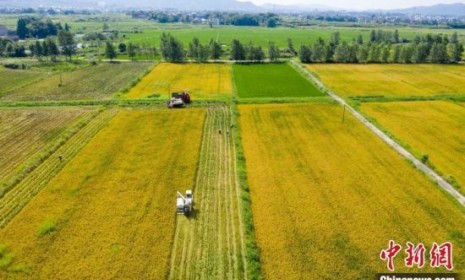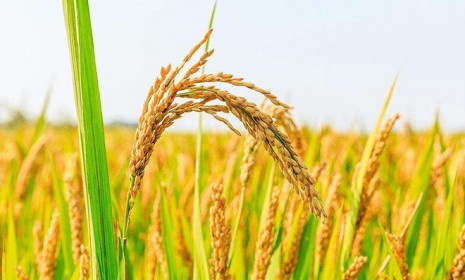2月8日,華中農(nóng)業(yè)大學生物信息團隊楊慶勇教授課題組在國際學術期刊Molecular Plant在線發(fā)表題為“BnVIR: bridging the genotype-phenotype gap to accelerate mining of candidate variations for traits in Brassica napus”的研究論文,該研究建立了甘藍型油菜基因型與基因表達、表型的關聯(lián),為快速、高效地挖掘油菜候選變異/基因提供了平臺。
該研究首先構建了一套由2,311個甘藍型油菜核心種質(zhì)鑒定的10,090,561個遺傳變異的數(shù)據(jù)集,其中包括SNP、InDel和不同種類的SV,這是目前已發(fā)表的最為系統(tǒng)、最為完整的甘藍型油菜遺傳變異集合。該研究以其中1,703個材料的18個性狀的表型數(shù)據(jù)和309個材料的RNA-seq數(shù)據(jù)為基礎,構建出甘藍型油菜變異信息資源數(shù)據(jù)庫BnVIR(http://yanglab.hzau.edu.cn/BnVIR)(圖1)。
圖1 BnVIR數(shù)據(jù)庫主頁、構建流程和概貌
該數(shù)據(jù)庫提供了群體水平的遺傳變異基因型與表型和基因表達量的關聯(lián),可輔助快速挖掘與油菜性狀相關的候選變異和基因(圖2)。此外,該數(shù)據(jù)庫為甘藍型油菜種質(zhì)資源的查詢、群體遺傳學和進化分析以及關聯(lián)分析等提供了多種工具。最后,該研究通過挖掘一些已報道的(如FLC.A10、FAE1.A08、FAE1.C03、FAD2.A05)和新鑒定的候選基因和功能變異的案例分析,以及獨立表型數(shù)據(jù)集的檢驗分析等系列工作,系統(tǒng)全面地展示了該數(shù)據(jù)平臺在挖掘與表型相關的候選變異和基因的潛力、可靠性與穩(wěn)健性(圖3)。與現(xiàn)有甘藍型油菜數(shù)據(jù)庫不同,BnVIR提供了更加全面、更加豐富的變異及其與多個組學數(shù)據(jù)的關聯(lián)和更加友好和豐富的用戶界面,可顯著提高研究者挖掘候選變異和基因的效率,并為甘藍型油菜的分子育種開發(fā)提供有價值的標記。
圖2 使用BnVIR數(shù)據(jù)庫驗證/挖掘候選基因/變異的實例
遺傳變異是物種表型多樣性形成的物質(zhì)基礎,包括單核苷酸多態(tài)性(SNP),小片段的插入/缺失(InDel)以及大規(guī)模結(jié)構變異(SV)。目前,遺傳變異已被廣泛應用于人類疾病、動植物重要農(nóng)藝或經(jīng)濟性狀相關遺傳位點的鑒定、重要功能基因的克隆、分子標記輔助選擇育種等工作。對于作物遺傳育種,準確了解遺傳變異對基因的調(diào)控效應以及與表型分化的關聯(lián),對種質(zhì)資源的精準鑒定和優(yōu)異等位基因的挖掘具有重要作用。
油菜作為世界四大油料作物之一,在全球范圍內(nèi)為人類的生活和生產(chǎn)提供優(yōu)質(zhì)的食用植物油和飼料蛋白來源。我國年均油菜生產(chǎn)和消費居世界首位,常年種植面積1億畝左右,占油料作物面積的50%以上,油菜安全生產(chǎn)在保障我國食用油供應和蛋白飼料需求上發(fā)揮著重要作用。近年來,經(jīng)過一代又一代油菜科學家的努力,我國油菜研究實現(xiàn)了從理論、技術、產(chǎn)品到轉(zhuǎn)化的鏈式創(chuàng)新,推動了我國油菜基礎研究與應用步入世界第一方陣(《中國農(nóng)業(yè)農(nóng)村科技發(fā)展報告(2012—2017)》)。然而,當前我國油菜大多仍以常規(guī)育種與分子標記輔助選擇育種技術為主,與國外大規(guī)模應用的以基因組選擇為核心的分子育種技術相比,在品種育成速度、成功率及效率等方面仍有較大差距。因此,如何將基礎研究中長期積累的資源和多組學數(shù)據(jù)(基因組、轉(zhuǎn)錄組等)優(yōu)勢轉(zhuǎn)化成育種優(yōu)勢,是當前油菜遺傳育種的核心研究內(nèi)容之一。
隨著后基因組代的到來,作物科學領域已積累海量數(shù)據(jù),利用生物信息技術將大規(guī)模的多組學數(shù)據(jù)進行系統(tǒng)的整合和分析,并構建更友好的圖形化、可視化數(shù)據(jù)庫,將極大促進重要農(nóng)藝性狀的功能基因的發(fā)掘及機制解析,推動優(yōu)異種質(zhì)資源的開發(fā)和利用,加快品種選育。這對發(fā)展高效、精準的新一代生物育種,打贏種業(yè)翻身仗具有重要意義。該研究不僅為甘藍型油菜今后的遺傳育種提供了重要平臺,也為其他作物進行整合和利用多組學數(shù)據(jù)推動育種產(chǎn)業(yè)發(fā)展提供重要參考。
我校信息學院楊慶勇教授為論文通訊作者,信息學院已畢業(yè)博士生楊植全(現(xiàn)廣州大學博士后)、博士研究生梁聰園和碩士研究生魏璐露為論文共同第一作者。我校作物遺傳改良國家重點實驗室周永明教授、郭亮教授對本研究提供了重要指導。該研究得到國家自然科學基金、國家重點研究發(fā)展計劃和中央高校基本科研業(yè)務費專項資金項目資助。
楊慶勇教授課題組近年來聚焦“油菜基因組學與分子育種”研究方向,先后與國內(nèi)多個研究團隊合作,通過系統(tǒng)整合和分析甘藍型油菜的多組學數(shù)據(jù),構建了首個油菜泛基因組(Nature Plants, 2020)及其數(shù)據(jù)庫BnPIR(Plant Biotechnology Journal, 2021)、油菜轉(zhuǎn)錄組數(shù)據(jù)庫BnTIR (Plant Biotechnology Journal, 2021)、油菜遺傳變異數(shù)據(jù)庫BnVIR(Molecular Plant, 2022)和植物遺傳變異參考面板數(shù)據(jù)庫Plant-ImputeDB (Nucleic Acids Research, 2021),搭建了我國自主可控的油菜參考基因組生態(tài)。目前在Molecular Plant、Nature Plants、Nucleic Acids Research、Plant Biotechnology Journal等雜志發(fā)表多篇油菜基因組和數(shù)據(jù)庫論文。
【英文摘要】
Genetic variations, which range from single nucleotide polymorphisms (SNPs) and short insertion/deletions (InDels) to large-scale structural variations (SVs), are the basis of phenotypic diversity. Understanding the effect of genetic variations on traits is critical for uncovering the genetic architecture of various phenotypes. In humans, great efforts have been made to catalog the huge amounts of variations in single locus and their functional and phenotypic impacts, as well as detect the genetic interactions between loci underlying complex diseases, which are of great significance for pathologic studies (Civelek and Lusis 2014; Karczewski et al., 2020; Li et al., 2013)。 In plants, the functional and phenotypic impacts of genetic variations remain largely unknown. As an important oil crop, Brassica napus (B. napus) provides high-quality vegetable oil and feed protein worldwide (Chalhoub et al., 2014)。 Substantial genotypic, transcriptomic and phenotypic data of B. napus have become available in public databases recently (Liu et al., 2021; Song et al., 2020; Yan et al., 2021), which provide important resources for molecular marker-assisted breeding and genetic improvement of B. napus. However, the mining of candidate variations/genes has been largely hindered by the lack of solid association between genotype and phenotype and the corresponding platform (Yan et al., 2021)。 Here, to bridge the gap between genotype and phenotype, we first constructed a large panel of genetic variations, and presented the most systematic and complete variations of B. napus, including SNPs, InDels and various SVs. Then, phenotype data from traits of 1,703 accessions and RNA-seq data of 309 accessions were used as a basis to assemble a B. napus variation information resource (BnVIR; http://yanglab.hzau.edu.cn/BnVIR)。 The database provides genotype-phenotype maps for rapid mining of candidate variations/genes associated with various traits in B. napus. Besides, it is the first platform for checking the genetic interactions between candidate loci or genes associated with quantitative traits.
論文鏈接:https://www.cell.com/molecular-plant/fulltext/S1674205222000508
日期:2022-02-09
該研究首先構建了一套由2,311個甘藍型油菜核心種質(zhì)鑒定的10,090,561個遺傳變異的數(shù)據(jù)集,其中包括SNP、InDel和不同種類的SV,這是目前已發(fā)表的最為系統(tǒng)、最為完整的甘藍型油菜遺傳變異集合。該研究以其中1,703個材料的18個性狀的表型數(shù)據(jù)和309個材料的RNA-seq數(shù)據(jù)為基礎,構建出甘藍型油菜變異信息資源數(shù)據(jù)庫BnVIR(http://yanglab.hzau.edu.cn/BnVIR)(圖1)。
圖1 BnVIR數(shù)據(jù)庫主頁、構建流程和概貌
該數(shù)據(jù)庫提供了群體水平的遺傳變異基因型與表型和基因表達量的關聯(lián),可輔助快速挖掘與油菜性狀相關的候選變異和基因(圖2)。此外,該數(shù)據(jù)庫為甘藍型油菜種質(zhì)資源的查詢、群體遺傳學和進化分析以及關聯(lián)分析等提供了多種工具。最后,該研究通過挖掘一些已報道的(如FLC.A10、FAE1.A08、FAE1.C03、FAD2.A05)和新鑒定的候選基因和功能變異的案例分析,以及獨立表型數(shù)據(jù)集的檢驗分析等系列工作,系統(tǒng)全面地展示了該數(shù)據(jù)平臺在挖掘與表型相關的候選變異和基因的潛力、可靠性與穩(wěn)健性(圖3)。與現(xiàn)有甘藍型油菜數(shù)據(jù)庫不同,BnVIR提供了更加全面、更加豐富的變異及其與多個組學數(shù)據(jù)的關聯(lián)和更加友好和豐富的用戶界面,可顯著提高研究者挖掘候選變異和基因的效率,并為甘藍型油菜的分子育種開發(fā)提供有價值的標記。
圖2 使用BnVIR數(shù)據(jù)庫驗證/挖掘候選基因/變異的實例
遺傳變異是物種表型多樣性形成的物質(zhì)基礎,包括單核苷酸多態(tài)性(SNP),小片段的插入/缺失(InDel)以及大規(guī)模結(jié)構變異(SV)。目前,遺傳變異已被廣泛應用于人類疾病、動植物重要農(nóng)藝或經(jīng)濟性狀相關遺傳位點的鑒定、重要功能基因的克隆、分子標記輔助選擇育種等工作。對于作物遺傳育種,準確了解遺傳變異對基因的調(diào)控效應以及與表型分化的關聯(lián),對種質(zhì)資源的精準鑒定和優(yōu)異等位基因的挖掘具有重要作用。
油菜作為世界四大油料作物之一,在全球范圍內(nèi)為人類的生活和生產(chǎn)提供優(yōu)質(zhì)的食用植物油和飼料蛋白來源。我國年均油菜生產(chǎn)和消費居世界首位,常年種植面積1億畝左右,占油料作物面積的50%以上,油菜安全生產(chǎn)在保障我國食用油供應和蛋白飼料需求上發(fā)揮著重要作用。近年來,經(jīng)過一代又一代油菜科學家的努力,我國油菜研究實現(xiàn)了從理論、技術、產(chǎn)品到轉(zhuǎn)化的鏈式創(chuàng)新,推動了我國油菜基礎研究與應用步入世界第一方陣(《中國農(nóng)業(yè)農(nóng)村科技發(fā)展報告(2012—2017)》)。然而,當前我國油菜大多仍以常規(guī)育種與分子標記輔助選擇育種技術為主,與國外大規(guī)模應用的以基因組選擇為核心的分子育種技術相比,在品種育成速度、成功率及效率等方面仍有較大差距。因此,如何將基礎研究中長期積累的資源和多組學數(shù)據(jù)(基因組、轉(zhuǎn)錄組等)優(yōu)勢轉(zhuǎn)化成育種優(yōu)勢,是當前油菜遺傳育種的核心研究內(nèi)容之一。
隨著后基因組代的到來,作物科學領域已積累海量數(shù)據(jù),利用生物信息技術將大規(guī)模的多組學數(shù)據(jù)進行系統(tǒng)的整合和分析,并構建更友好的圖形化、可視化數(shù)據(jù)庫,將極大促進重要農(nóng)藝性狀的功能基因的發(fā)掘及機制解析,推動優(yōu)異種質(zhì)資源的開發(fā)和利用,加快品種選育。這對發(fā)展高效、精準的新一代生物育種,打贏種業(yè)翻身仗具有重要意義。該研究不僅為甘藍型油菜今后的遺傳育種提供了重要平臺,也為其他作物進行整合和利用多組學數(shù)據(jù)推動育種產(chǎn)業(yè)發(fā)展提供重要參考。
我校信息學院楊慶勇教授為論文通訊作者,信息學院已畢業(yè)博士生楊植全(現(xiàn)廣州大學博士后)、博士研究生梁聰園和碩士研究生魏璐露為論文共同第一作者。我校作物遺傳改良國家重點實驗室周永明教授、郭亮教授對本研究提供了重要指導。該研究得到國家自然科學基金、國家重點研究發(fā)展計劃和中央高校基本科研業(yè)務費專項資金項目資助。
楊慶勇教授課題組近年來聚焦“油菜基因組學與分子育種”研究方向,先后與國內(nèi)多個研究團隊合作,通過系統(tǒng)整合和分析甘藍型油菜的多組學數(shù)據(jù),構建了首個油菜泛基因組(Nature Plants, 2020)及其數(shù)據(jù)庫BnPIR(Plant Biotechnology Journal, 2021)、油菜轉(zhuǎn)錄組數(shù)據(jù)庫BnTIR (Plant Biotechnology Journal, 2021)、油菜遺傳變異數(shù)據(jù)庫BnVIR(Molecular Plant, 2022)和植物遺傳變異參考面板數(shù)據(jù)庫Plant-ImputeDB (Nucleic Acids Research, 2021),搭建了我國自主可控的油菜參考基因組生態(tài)。目前在Molecular Plant、Nature Plants、Nucleic Acids Research、Plant Biotechnology Journal等雜志發(fā)表多篇油菜基因組和數(shù)據(jù)庫論文。
【英文摘要】
Genetic variations, which range from single nucleotide polymorphisms (SNPs) and short insertion/deletions (InDels) to large-scale structural variations (SVs), are the basis of phenotypic diversity. Understanding the effect of genetic variations on traits is critical for uncovering the genetic architecture of various phenotypes. In humans, great efforts have been made to catalog the huge amounts of variations in single locus and their functional and phenotypic impacts, as well as detect the genetic interactions between loci underlying complex diseases, which are of great significance for pathologic studies (Civelek and Lusis 2014; Karczewski et al., 2020; Li et al., 2013)。 In plants, the functional and phenotypic impacts of genetic variations remain largely unknown. As an important oil crop, Brassica napus (B. napus) provides high-quality vegetable oil and feed protein worldwide (Chalhoub et al., 2014)。 Substantial genotypic, transcriptomic and phenotypic data of B. napus have become available in public databases recently (Liu et al., 2021; Song et al., 2020; Yan et al., 2021), which provide important resources for molecular marker-assisted breeding and genetic improvement of B. napus. However, the mining of candidate variations/genes has been largely hindered by the lack of solid association between genotype and phenotype and the corresponding platform (Yan et al., 2021)。 Here, to bridge the gap between genotype and phenotype, we first constructed a large panel of genetic variations, and presented the most systematic and complete variations of B. napus, including SNPs, InDels and various SVs. Then, phenotype data from traits of 1,703 accessions and RNA-seq data of 309 accessions were used as a basis to assemble a B. napus variation information resource (BnVIR; http://yanglab.hzau.edu.cn/BnVIR)。 The database provides genotype-phenotype maps for rapid mining of candidate variations/genes associated with various traits in B. napus. Besides, it is the first platform for checking the genetic interactions between candidate loci or genes associated with quantitative traits.
論文鏈接:https://www.cell.com/molecular-plant/fulltext/S1674205222000508
日期:2022-02-09















